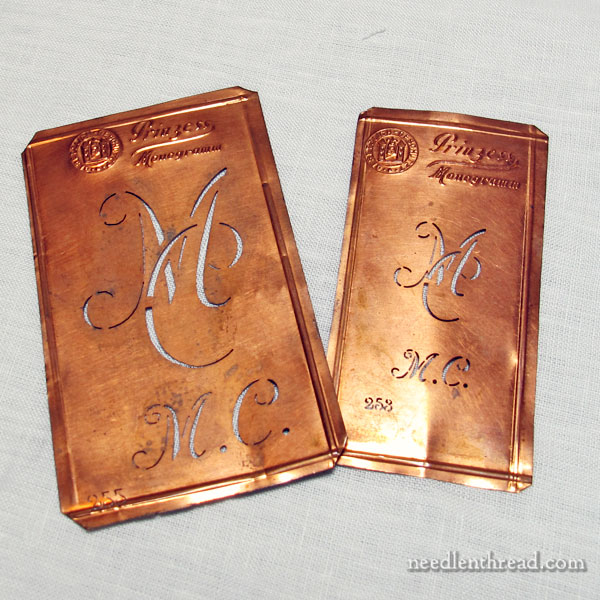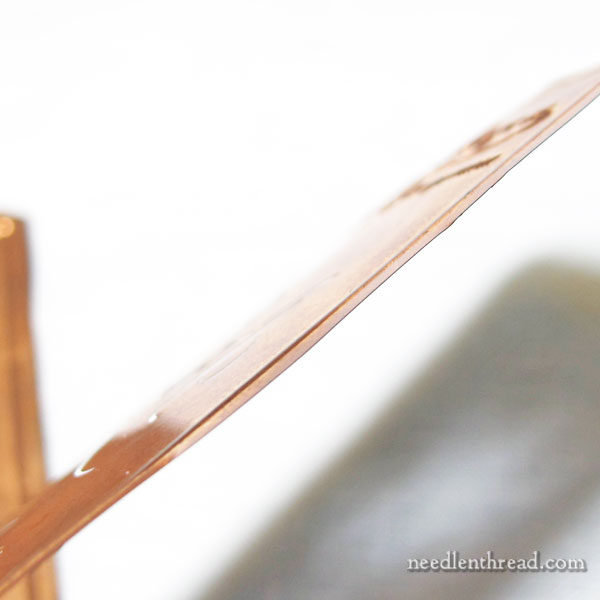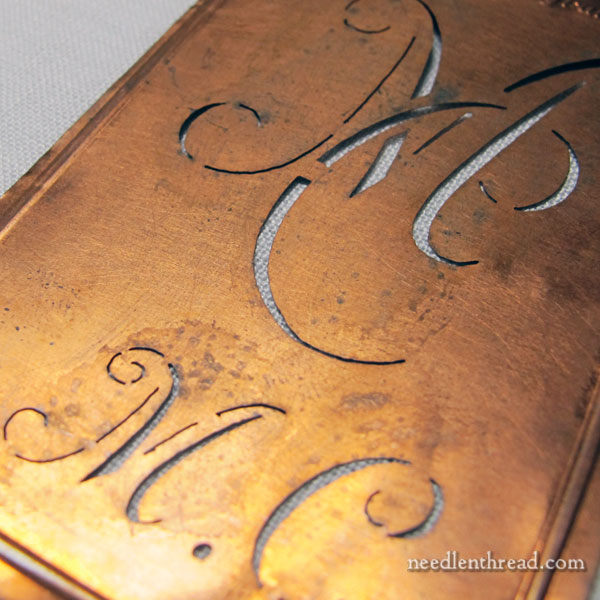Howdy ho, and a happy Wednesday!
Let’s talk antiques!
Way back in the Victorian era and through the early 20th century, embroidering initials on clothing (especially one’s intimate wear) and on household linens was a common practice.
While the embroidered monograms could be elaborate and highly decorative – in which cases, they might be worked in prominent places on household linens where they could be seen – embroidered monograms served a much more mundane purpose. They were simply laundry markings.
A young lady would commonly mark her trousseau of under clothing, intimate apparel and the linens that she would bring to her new household with hand stitched initials. When laundered (as laundry was often “sent out”), her linens would make it back to her own closets.
Once betrothed, the initials could be more particular – the new household linens could include her spouse’s initial as well.

To expedite the transfer of the design of the initials onto fabric, monogram stencils came about. These were made of very thin metal sheets – sometimes copper, sometimes tin – and the initials could range in design from very simple to fairly elaborate.
Those with particular tastes or particular styles of lettering in mind could, for the right price, have stencils custom made, or they could select from a less-expensive, ready-made variety of letters.
Sometimes, these sheet metal stencils can be found in full alphabets, but often they’re found in old sewing boxes in a more limited range of letters, since the embroiderer was often only concerned with household initials.

The metal sheets the stencils are cut from are paper thin. They’re downright flimsy (in a good way), they’re so thin!
The initials are cut with perfect accuracy, and they offer a quick way of transferring a clear lettering design onto fabric.

If you look at old copper stencils up close – if they were once used and they haven’t been cleaned and polished – you can see wet marks on the copper from previous transfers.
The stencils would have been used either with an ink sold for the purpose or with a pounce powder that was dampened with spirits – today, we’d use rubbing alcohol, I think. The alcohol moistens the pounce powder into a liquid form, but then it evaporates, leaving the markings of the pounce adhering to the fabric.
I’ve not tried pounce and alcohol, but it’s one of those experiments I’m going to make some day – and maybe some day soon! Now that I have a set of these copper stencils in hand, my curiosity is piqued!
I’ve seen old advertisements for copper stencils, and I’ve seen plenty of them available on eBay and Etsy. But I’ve never taken the plunge and invested in any. I think they’re beautiful, once you see them in person! There’s just something about their delicacy, the warm shine of the copper, the history behind them…
A Kind Gift
This particular set came way of Jessica Grimm, who became fascinated with sheet monogram stencils and started collecting them. She sent along the two MC sheets above to a very grateful recipient! Thank you, Jessica!
Jessica first wrote about the stencils on her blog, here, where she offers a free PDF download of an old Johann Merkenthaler catalog. This was a German company that produced very fine sheet copper monogram stencils. The catalog is packed full of examples of the Merkenthaler stencils – so, lots of lettering images available there!
Jessica also wrote about her method of transferring initials to fabric using the stencils and a modern transfer pen. So, yes, the stencils can easily be used today, if you happen to have a collection of them!
Coming Up – My Experiments & Some Tips
I’ve been playing with the stencils, too, and trying out different methods of using them.
So, next up, I’ll show you my little experiments with different transfer mediums, tell you which ones seemed to work best for me, and take you step-by-step through a quick, simple method of embroidering the monograms while retaining the penmanship-like shape of the letters.
We’ll also chat about the possibilities of using stencils today – not necessarily these antique ones, but stencils that you could make for yourself.
Interested in Exploring Further?
You might enjoy this video, wherein an antique dealer explores up close a collection of copper sheet monogram stencils. The collection is rather limited in letters. I was intrigued, too, by the sewing box and the tin holding the copper stencils:
(If you’re reading this in your email, you can stop by Needle ‘n Thread to view the video here.)
If you’re interested in collecting these copper sheet monogram stencils, you’ll find a slew of them on eBay and some on Etsy. They’re very pretty, and I could see using them (not the embroidery, but the stencils themselves!) as focus points in mixed media projects, in collage pieces and the like.
So there’s something else for you to explore, if you love monograms!
Enjoy your day!







Hi Mary.
I enjoyed the video! It’s so interesting seeing a piece of embroidery history – one of the MANY things I love about embroidery is the historical connection. I just ordered a couple of stencils from Jessica Grimm and I’m looking forward to “playing” with them.
Thank you for another great post.
Oh, this is so cool! I finally now understand what those thin copper monogram sheets of my grandmother’s are. I couldn’t quite understand what they were for. Now it is totally clear. LOVE the old catalog too. Thanks for sharing!
I am super excited to learn about stencils you can do yourself. That sounds like so much fun!
What an interesting and informative post. Love, love, love the history lesson. I’ll have to keep my eye out for some of these at the local antique malls. Thank you!!
Dear Mary,
Thank you so much for mentioning me again! I am looking forward to your expirements with them. When they transfer a pricking in Appenzell, they use black pounce powder and then they fixate with Talens fixative spray https://www.royaltalens.com/brands/talens/auxiliaries/fixatives-for-pastels/talens-concentrated-fixative-064/. The black does not rub off on the light blue threads. And it goes completely upon high-temperature washing. However, I have not tried it for myself yet.
Have a nice day, Jessica
I found you quite by accident a few months ago when I first started researching embroidery crafts. I am still researching and to my delight when I imput a certain search word in search engines I am amazed at how often you and your blog pop up in first or second place as search result! It is like discovering an old friend.
Very interesting. A change from the earlier laundry markings in the 18th century.
As a 1770s reenactor I know that in “our” period ) and, I presume before same, “small clothes” (the equivalent of our modern underwear – but not all of it was actually worn under clothes) the shirts and shifts were almost identical from adult person to adult person as they were loose garments and might not vary in size enough to be noticed if they varied at all.
Shirts were the main undergarment for boys over around 6 years old and men. The shirt would almost always be white and would be knee length – men’s under breeches start to come into being just after our period. Shifts, always white, were worn by women and girls as well as ALL children under 6. No sort of under pants were in usage until the late r 19th century. (Having worn my reproduction garments with modern underpants – it is not easy to deal with same – especially in the modern equivalent of the “necessary house” – the portable toilet.) The major difference would be a lesser fabric possibly used for those of the servants (including what we today call enslaved people) than that of the family – although depending on the family and its means, this was not always true. Linen was the common fabric to be used for shirts and shifts.
To tell mom’s shift from 16 year old daughter’s shift or dad’ shirt from grandpa’s shirt the garments were marked with the marking stitch on the bottom edge of the garment. A number was also added so that one had, for example, shift 1, shift 2, shift 3 this was to help keep further track of the laundry and to be able to rotate garments to give them longer life. (Bed linens and such were also marked with the number of the item.) A small pincushion would be embroidered with a listing of the various items and where they might be so that one could keep track with pins of if they were ready to be used, being laundered, or being repaired – woe if it was missing as fabric was expensive.
The marking stitch is what we call today call the cross stitch. It started as the stitch to mark garments and linens and then became used as a decorative stitch.
Stockings (thigh high socks for all), handkerchiefs (small as we know then and large worn as a sort of shawl around one over one’s clothes) and ladies’ caps were also considered small clothes. These would also be marked in the same manner.
I know that Beryl Taylor, a mixed media and textile artist uses copper stencils with intricate designs in her work. Not sure where she gets them, but they must be out there.
Mary,
The information on the copper stencils is so interesting and I have never heard of them or seen any. Bravo for Jessica for sending you some. I know that you will have fun with them.
Ann B.
Totally unfamiliar to me, your feature on these historical monogram copper stencils (and in favorite art nouveau era lettering) was indeed a treat. I might give another look to the brass stencils I’ve purchased through the years when we had paper crafts/rubber stamp shows in our area. I’ve used those with embossing pastes (the Celtic knot designs attracted me). Once again, Mary, you expand our resources. Christine
Mary I have seen on videos that pounce is still used in its powder form by the Parisian ateliers and couture designers. I look forward to seeing your tests and tryouts for these stencils.
Hello im BM3 im in the United States Navy and were trying to order a sheet metal with our job logo theyre cross anchors if you google boatswain mate cross anchors that’s what it is